The First Fifty Years – Part One
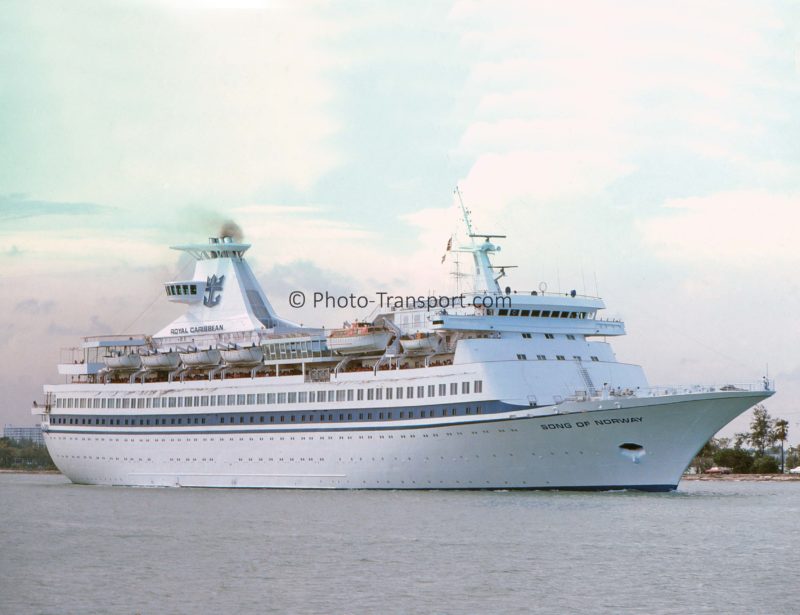
On 7th November 1970 the brand new Song of Norway, the first Royal Caribbean Cruise Line vessel, departed Miami on its maiden cruise. Fifty years later the company is one of the world’s top two cruise conglomerates, with 77,000 employees and six different brands operating 63 ships.
It can be said that Royal Caribbean rose from the ashes of tragedy. On the afternoon of 12th November 1965, the Yarmouth Castle, dating from 1927, departed Miami with 371 passengers on board for a short cruise to the Bahamas. Shortly after midnight, Yarmouth Castle caught fire about sixty miles from Nassau, sinking a few hours later with the loss of eighty-nine lives. However, their deaths were not in vain, as this disaster resulted in legislation being passed by the United States Government and an international agreement being reached that would make cruise ships of the future safer.
Although being operated on charter to Caribbean Cruise Line at the time, Yarmouth Castle along with its sister ship, Yarmouth, was owned by Yarmouth Steamship Line, whose general manager was Edwin Stephan, a very unlikely person to become involved in the cruise industry. Born in 1931 in Madison, Wisconsin, and growing up there, far from the sea, he attended the University of Wisconsin before serving in the Korean War as an Army lieutenant, receiving two Bronze Stars during his service. He didn’t particularly like to travel and was prone to seasickness, but a holiday trip to Miami prompted him to move there.
Stephan started working as a bell captain at the Casablanca Hotel, and then managed the Biscayne Terrace Hotel in downtown Miami. In 1962, Stephan joined the Yarmouth Steamship Company as general manager, and the months following the sinking of Yarmouth Castle were particularly difficult for him. In April 1966 the company went bankrupt, and this could have been the end of Edwin Stephan in the cruise industry.
Instead, believing cruising had a bright future, Stephan joined Commodore Cruise Line as its President. Founded in 1966 by Sanford Chobol, a Florida hotel owner. Commodore arranged to charter a vessel then under construction in Finland, which had been ordered by a Swedish ferry company, to carry about 1,400 passengers and 300 cars, but was bought while under construction by a German company, Wallenius Lines, by whom it was chartered to Commodore, and became the first cruise ship built in Finland. The vessel, which was named Boheme, departed Miami on its first cruise on 7th December 1968, and Commodore became the first company to operate week-long cruises out of Florida all year, to Freeport in the Bahamas, St. Thomas, San Juan and Cap Haitien. Boheme had small cabins for 460 passengers, and a large vehicle deck that remained unused, but became quite popular for sporting activities.
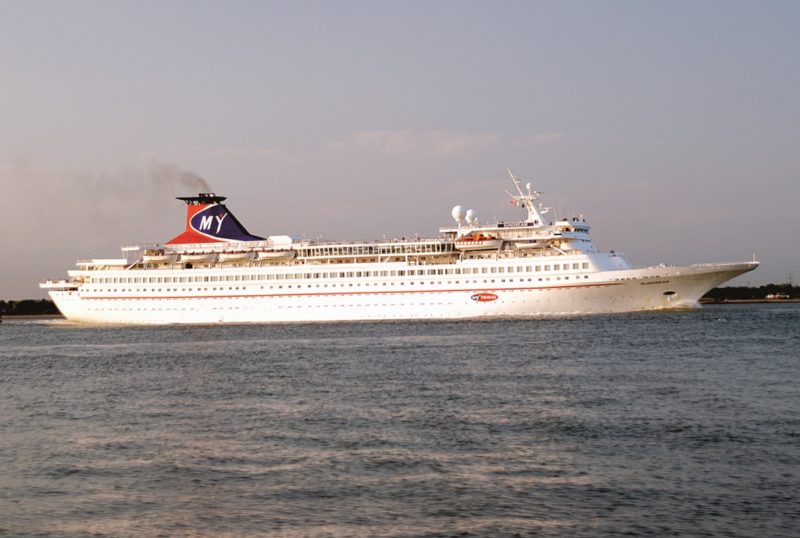
Boheme was not the first car ferry to be used as a cruise ship from Miami, as Ted Arison had been operating the chartered ferry Nili on short cruises to the Bahamas. This operation had been successful, but came to a sudden conclusion when the ship was arrested for unpaid debts not associated with Arison in November 1966. Desperate to keep his cruise operation going, Arison was able to obtain a new car ferry, Sunward, built for the Klosters organisation, which began cruising out of Miami on 19th December 1966. This proved so successful that a new cruise ferry was built, which entered service in December 1968. The operating company was named Norwegian Caribbean Line before a third vessel was added in December 1970 as Skyward, which did not have a car deck.
Norwegian Caribbean Line provided major competition for Commodore Cruise Line, and although the Commodore operation was enjoying some success, Edwin Stephan believed there was a large community of extremely wealthy Americans in Florida who would be prepared to pay top dollar for a short, relaxing luxury cruise to the Caribbean. However, to attract them the cruise market needed something better than an ex-car ferry.
Edwin Stephan began canvassing for investors to enable him to establish a new company that would operate a fleet of purpose-built luxury cruise liners from Miami. His plan was to have three ships, one making 7 day cruises and two offering 14 day cruises, which would result in two ships departing Miami every Saturday.
Stephan went to Norway in 1968 to meet with local ship owners, managed to secure financial backing for his plan from Anders Wilhelmsen and Sigurd Skaugen, and orders were placed with the Wartsila shipyard in Helsinki for two ships of a modern design unlike anything then in service. After cutting his ties with Commodore on 31st January 1969, Royal Caribbean Line was formed in Miami, with Edwin Stephan as President. “We believe Miami has a destiny as the cruise capital of the world”, Stephan said in a 1969 interview with the Miami Herald. A third Norwegian shipowner, Gotaas Larsen, also invested in the new company and in August 1969 an order for a third ship was placed with the Wartsila shipyard.
The first ship was launched on 12th December 1969 and named Song of Norway. Costing US$14.3 million, the 18,416 gross ton liner was fitted with luxurious staterooms for 724 passengers, and the major public rooms were named after musicals, including the ‘My Fair Lady’ lounge, 448 seat ‘The King and I’ dining room, and the 262 seat ‘South Pacific’ which doubled as a saloon and theatre. The highlight was the ‘Viking Crown’ bar-lounge located on the aft side of the funnel to provide spectacular views, and would become a Royal Caribbean trademark.
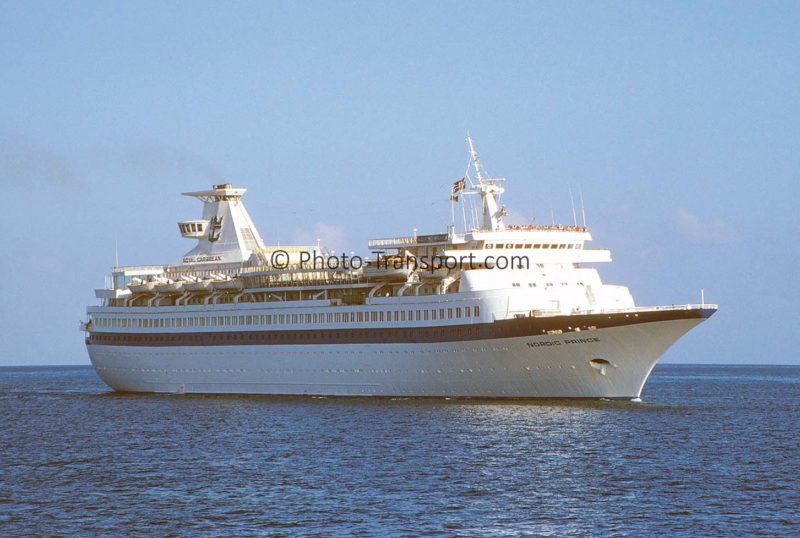
Song of Norway departed Miami on Saturday 7th November 1970 on its maiden cruise, to Nassau, San Juan and St. Thomas, and this itinerary would be followed throughout the year. Royal Caribbean was soon faced with serious competition, as on 3rd December 1970 Norwegian Caribbean Line introduced their latest vessel, the 16,607 gross ton Southward, which began operating year-round 14 day cruises from Miami.
The second ship being built for Royal Caribbean, which had been launched on 9th July 1970 and named Nordic Prince, was basically identical to Song of Norway, though fitted out to carry 714 passengers. On 31st July 1971, Nordic Prince departed Miami on the first 14 day cruise to be operated by Royal Caribbean, going to Nassau, San Juan, St. Thomas, Fort de France, Curacao, La Guaira, Aruba, Montego Bay and Haiti.
However, towards the end of 1971, having terminated their working arrangement with Ted Arison in rather acrimonious circumstances, Klosters had taken full control of Norwegian Caribbean Line. Arison was keen to stay in the cruise industry, and in February 1972 started his own company, Carnival Cruise Line, with one second-hand ship, Mardi Gras, offering cruises from Miami in competition with both Royal Caribbean Cruise Line and Norwegian Cruise Line.
The third vessel built for Royal Caribbean in Finland was the Sun Viking, launched on 27th November 1971, and departed Miami on 10th November 1972 on a 14 day cruise, going to Nassau, San Juan, St. Thomas, Fort de France, St George’s, Port of Spain, La Guaira, Curacao and Port-au-Prince. Edwin Stephan’s dream of two ships departing Miami every Saturday throughout the year on cruises had been realised, and the modern cruising era had commenced.
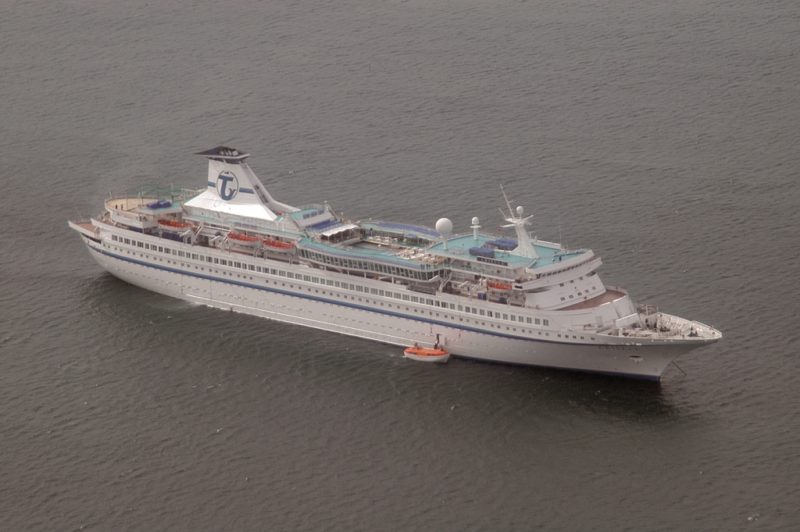
Over the following years the Royal Caribbean operation was steadily developed, and while Song of Norway maintained its original 7 day itinerary, the 14 day itineraries were altered to allow more sea days. In 1974 Nordic Prince was operating to San Juan, St Thomas, Fort de France, Curacao, La Guaira, Aruba, Curacao, Port Antonio and Port-au-Prince, while Sun Viking went to San Juan, St. Thomas, Guadeloupe, Grenada, Bridge-town, La Guiara, Curacao and Port-au-Prince.
Although the original intention had been to concentrate on attracting rich residents of Florida to cruises, Royal Caribbean was soon looking toward other markets, including the west coast. The company introduced an ‘air-sea’ package from San Francisco and Los Angeles, chartering aircraft to fly passengers to Miami and including a short tour of the city before they embarked, while after disembarking they were flown home, all at a cost of $60, so the minimum total cost of a 7 day was $368 per passenger.
By 1978, Royal Caribbean was unable to satisfactorily meet the demand for berths on their three ships, with waiting lists of up to eighteen months. Clearly more berths were needed, but it would take at least two years to have a new ship designed and built, so the decision was made to have Song of Norway lengthened at the Wartsila shipyard in Helsinki, where it was built.
On 30th August 1978, Song of Norway arrived at the shipyard, where a 26m/85ft long new centre section had been built, containing 164 cabins and extended public room space. The ship was cut in two and the stern section floated out of the drydock, then the new section was floated in and placed in position, the stern was brought back into the dock and the three sections joined together. Song of Norway, now measuring 22,945 gross tons with accommodation for 1,196 passengers as well as enlarged public rooms and more open deck space, returned to service with a departure from Miami on 26th November, having been out of service for only fourteen weeks.
The stretching of Song of Norway proved so successful that on 7th March 1980 Nordic Prince arrived at the Wartsila shipyard in Helsinki to have a new centre section inserted. When the work was completed on 17th June, Nordic Prince was 23,149 gross tons and could carry 1,194 passengers.
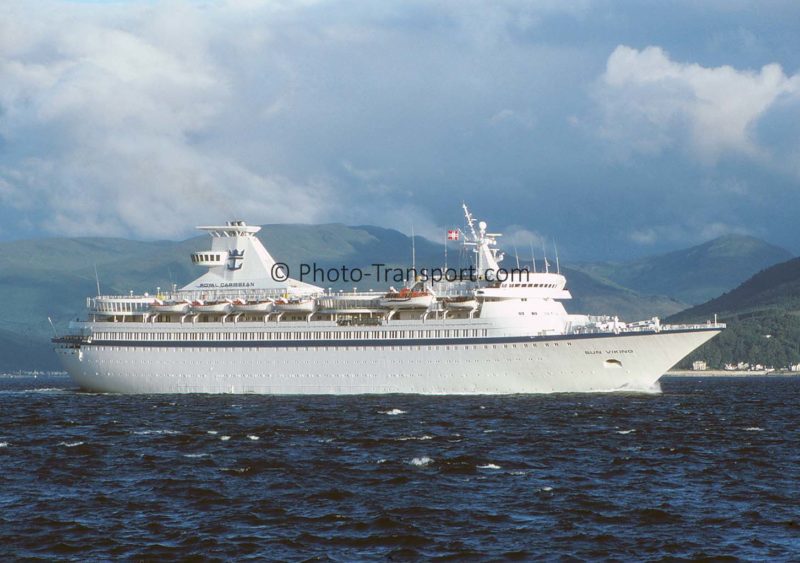
Instead of lengthening the third sister, Sun Viking, an order was placed with the Wartsila shipyard in Helsinki for a new ship, which would be twice the size of Sun Viking and carry double the number of passengers. Floated out of the building dock on 26th November 1981, the new vessel was named Song of America. Completed a year later, Song of America arrived in Miami on 24th November, and during the official naming ceremony held at Miami on 3rd December, opera star Beverley Sills managed to miss the ship completely on five swings of the champagne bottle, so the managing director of Wartsila, Martin Saarikangas, stepped in and broke the bottle next to the lower deck entrance. At 37,584 gross tons, Song of America was the sixth largest cruise liner in the world, could accommodate 1,535 passengers in 633 cabins, and featured a greatly enlarged ‘Viking Crown’ lounge that wrapped right around the funnel. On 5th December, Song of America joined the initial trio operating out of Miami, departing every Sunday on 7 day cruises to Nassau, San Juan and St Thomas.
With four ships operating very successfully, in late 1983 Royal Caribbean began designing a ship for the future, and in August 1985, a contract was signed for the construction of a revolutionary liner that would be twice the size of Song of America. It would be built by Chantiers de l’Atlantque at St Nazaire in France, in the same shipyard as the famous Normandie, and be delivered in December 1987.
Meanwhile, Royal Caribbean was gradually expanding its cruise ports, and had begun making occasional cruises to Bermuda, mostly by Nordic Prince. The company secured a five-year contract with the Bermuda Government to provide a regular summer service from New York, commencing in 1985, when Nordic Prince operated between 20th April and 21st September, making 23 visits to Hamilton, where four days were spent each week. This was the start of a lengthy connection with Bermuda.
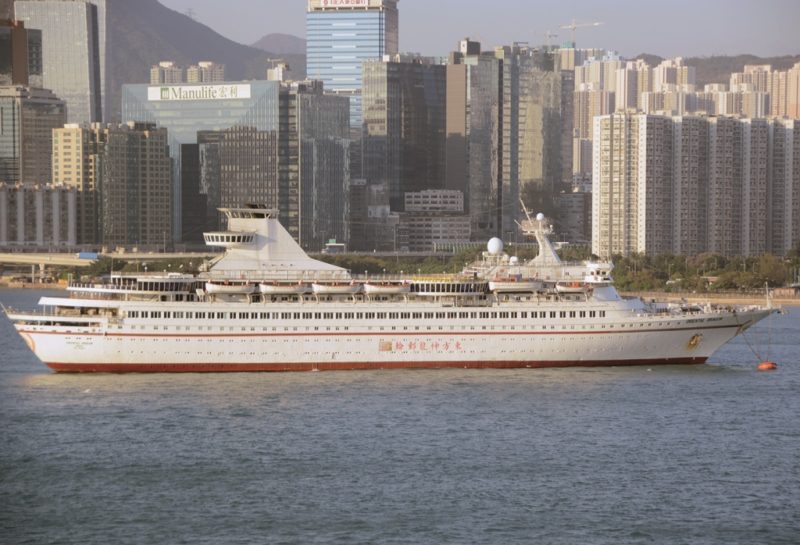
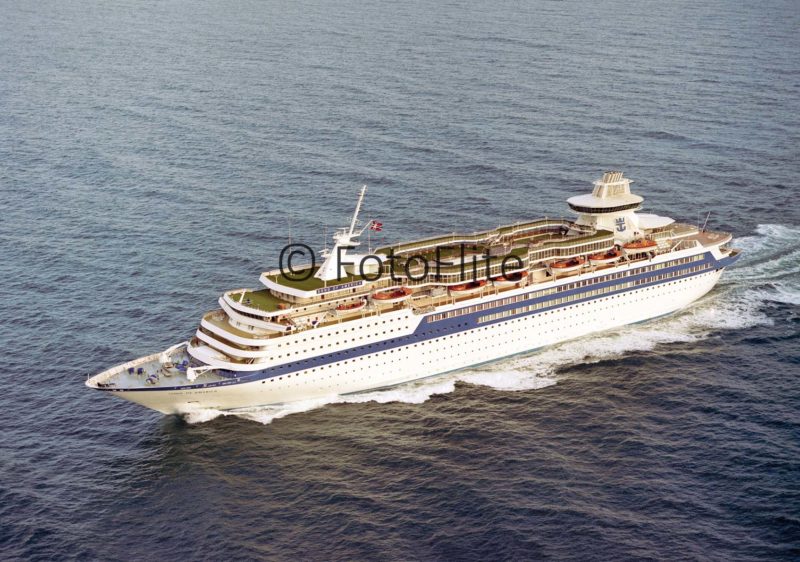
Royal Caribbean became the first cruise line to have their own private destination when, in 1986, they leased a 260 acre property on the coast of Haiti, and spent more than $3 million to create a luxury resort, with no impact on the area’s remarkable pristine beauty. Named Labadee, it is for the exclusive use of passengers to spend a day there while their ship is anchored offshore, and two specially designed tenders transfer them to shore. In 1988, Royal Caribbean leased Little Stirrup Cay, an island in the Bahamas, which became their second private resort as Coco Cay.
On 19th December 1987, four days ahead of the contract date, Royal Caribbean took delivery of what was then the largest cruise liner ever built, the 73,192 gross ton Sovereign of the Seas, With accommodation for a maximum of 2,524 passengers in 1,141 cabins, 722 outside and 419 inside, Sovereign of the Seas was notable for having the first modern shipboard atrium, five decks high with glass elevators, and an entire deck devoted to cabins with private balconies, and the trademark Viking Crown Lounge enveloping the funnel. Other features were twin 650 seat dining rooms, the 900 seat Windjammer Café featuring both indoor and outdoor tables, the 1,050 seat two deck high Follies Lounge for shows, and two cinemas.
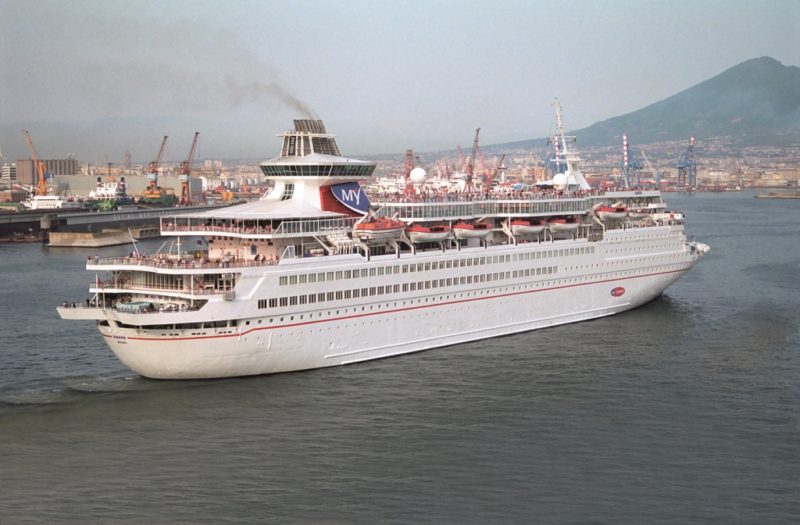
The first arrival of Sovereign of the Seas in Miami, on 4th January 1988, caused a sensation, being the largest vessel ever to enter the port and dwarfing all the other ships there. Rather unfortunately described by a Royal Caribbean representative as ‘the world’s first floating shopping mall’ while showing visitors around the new liner, the sheer size of everything inside and out left them stunned. An official naming ceremony by Mrs Rosalind Carter, wife of the former president, was held on 15th January, and the next day Sovereign of the Seas departed Miami on the first of its year-round 7 day cruises to St. Thomas, San Juan and Labadee.
Shortly after Sovereign of the Seas entered service there was a major change in the company. Gotaas Larsen, who owned a one-third share of Royal Caribbean, also had a 51% interest in Admiral Cruises, a much smaller operation formed in October 1986 by the amalgamation of two small cruise companies they owned, Eastern Cruise Lines and Western Cruise Lines, with Sundance Cruises, in which they held a majority interest. Admiral Cruises had three vessels, Emerald Seas, operating 3 and 4 day cruises from Miami to the Bahamas, Azure Seas making 3 and 4 day cruises out of Los Angeles, and Stardancer, offering 7 day trips from Los Angeles to Mexico in winter and Vancouver to Alaska in summer. In late 1987 Admiral ordered a ship to be built in France and delivered in 1990, referred to as Future Seas, and intended for the short cruise market out of Miami.
In March 1988, at the behest of Gotaas Larsen, Royal Caribbean and Admiral were merged under a newly formed holding company, Royal Admiral Cruises, giving them the largest cruise fleet in the world at that time. The three original shareholders in Royal Caribbean had control of approximately 96% of the stock in the new company, with Gotaas-Larsen holding a 36% interest. The remaining stock was shared between Gotaas-Larsens former partners in Sundancer Cruises, EFFOA-Finland Steamship Co. Ltd., the Johnson Line of Sweden, Oceanic Finance Corp Ltd. and McDonald Enterprises Ltd., which was headed by Stanley McDonald, who had founded Princess Cruises in 1965 and sold that company to P&O in 1974. Despite the merger, Royal Caribbean and Admiral Cruises continued to operate as totally separate entities.

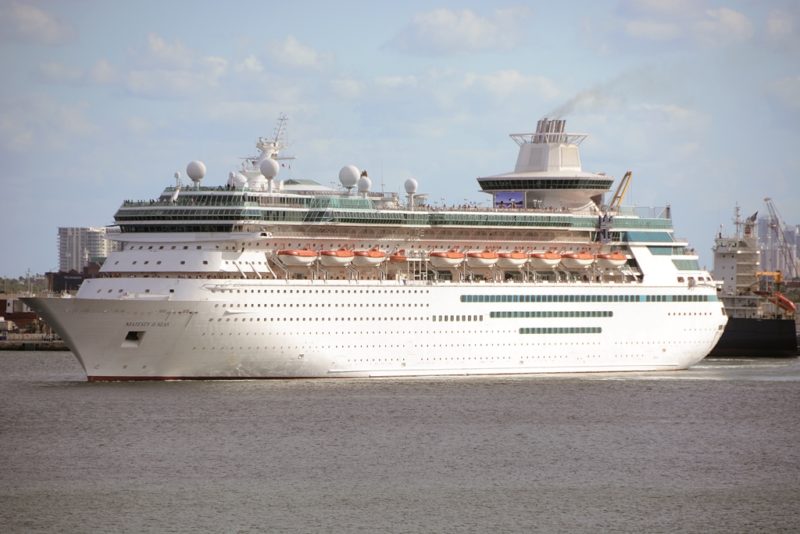
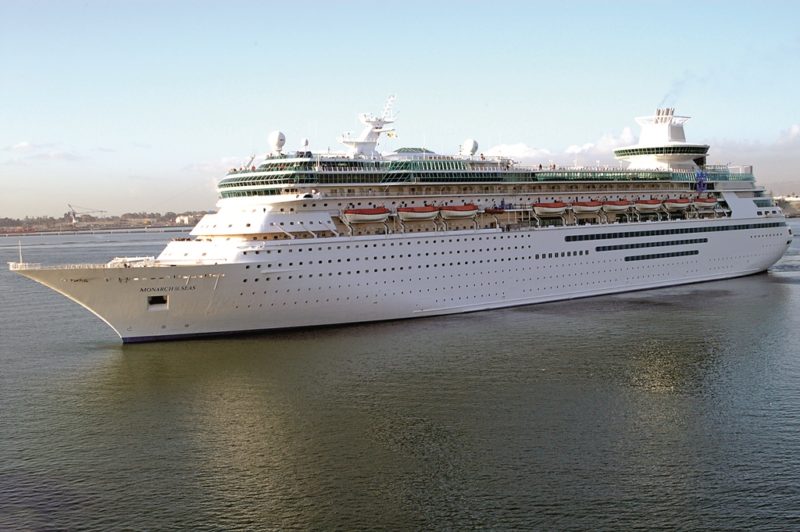
Royal Caribbean had enjoyed so much success with the summer cruises from New York to Bermuda by Nordic Prince, they decided to double their presence in the Bermuda market during the peak summer period of 1988 by adding Song of Norway to the service. Song of Norway had operated only from Miami until the end of 1987, when, with the arrival of Sovereign of the Seas, it was transferred to San Juan. In late May, Song of Norway left San Juan on a cruise to New York, and made thirteen trips to Bermuda between 8th June and 31st August. Both ships went first to St. George’s for one day, then moved to Hamilton for three days, with Nordic Prince at No 1 and Song of Norway at No 7. In September, Song of Norway returned to San Juan.
Later in 1988 Royal Caribbean was suddenly faced with a situation that could have seen the company disappear completely, or become a minor subsidiary of another operator, when Gotaas Larsen decided to leave the cruise industry. On 17th August 1988 it was reported Larsen had agreed to sell his holding in Royal Admiral Cruises to Carnival Cruise Lines, the major rival of Royal Caribbean, for $270 million. Soon after, it was reported that Carnival had also arranged to purchase the shareholding of Sigurd Skaugen and two others in Royal Admiral Cruises, the total price being $550 million. On Thursday 1st September, the Los Angeles Times reported:-
Carnival Cruise Lines Inc., moving to bolster its position in the cruise industry, said Wednesday that it has agreed to buy 70% of Royal Caribbean and Admiral Cruise Lines for $550 million in cash.
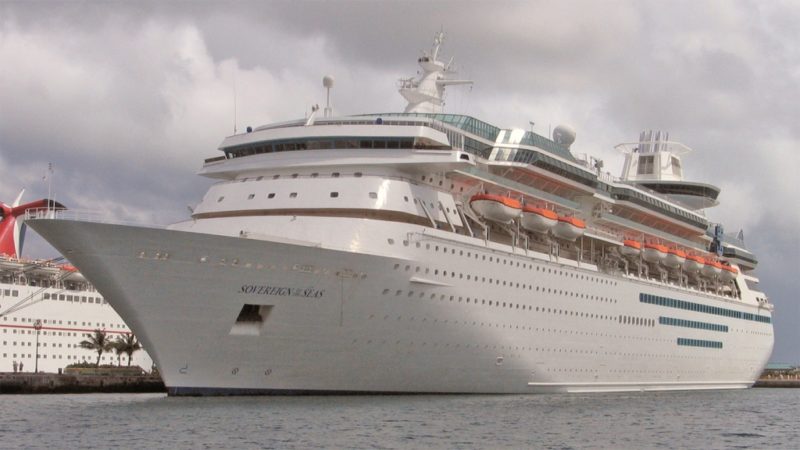
Carnival, which was the world’s largest line in 1987 based on the number of passengers carried, said on 17th August that it had agreed to buy a 36% position in the two lines from Gotaas-Larsen Shipping Corp. However, in Wednesday’s announcement the Miami-based company said it will increase that stake through additional purchases from I M Skaugen A/S, Jonnson Line AB and EFFOA-Finland Steamship Co. Ltd.
However, under the terms agreed by the three partners when Royal Caribbean Cruise Line was formed in 1970, it was accepted by all parties that the other major shareholder, Anders Wilhelmsen, had to be given the first option to buy out his partners. This was what Wilhelmsen intended to do, but the necessary funds to match the Carnival bid had to be raised in just thirty days. On Thursday 6th October, the New York Times reported:-
A bid to merge two of the nation’s largest cruise lines was thwarted today when a Norwegian partner in Royal Admiral Cruises Ltd. bought 70 percent of the company’s stock for $561 million, heading off a similar offer by Carnival Cruise Lines Inc. The surprise announcement was made in Oslo by Arne Wilhelmsen, who controls 30 percent of Royal Admiral’s stock. He said his shipping company, Anders Wilhelmsen & Company, had exercised its right to buy the balance of Royal Admiral’s shares.
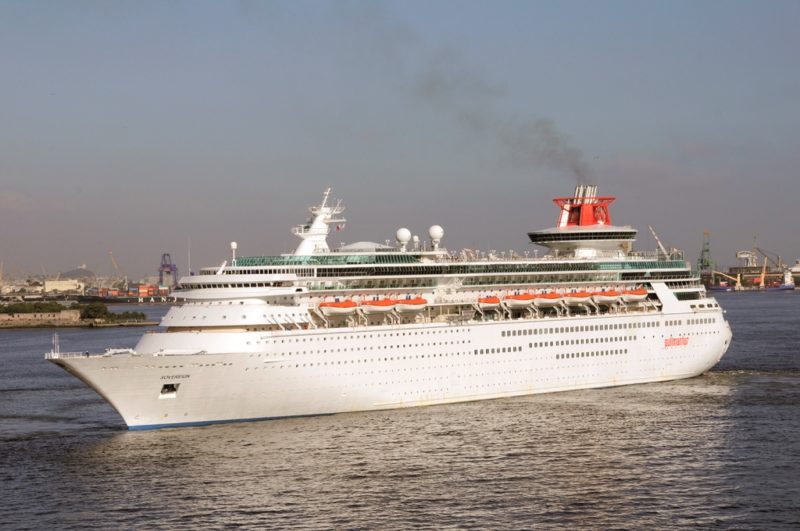
“This transaction will give Royal Admiral the flexibility and opportunity to boldly move ahead with Royal Admiral’s expansion plans”, Mr. Wilhelmsen said. He also announced that his company was negotiating to form a joint venture with an entity related to the Pritzker family, the owner of the Hyatt hotel chain. Royal Admiral’s chairman and chief executive, Richard D. Fain, said that under the proposed deal with the Pritzkers, Wilhelmsen would sell them 50 percent of the cruise company’s stock. Mr Wilhelmsen beat a deadline of next Monday to exercise his option.
The 50-50 joint venture between Anders Wilhelmsen & Company and the Pritzkers was finalised, securing the future of Royal Admiral Cruises. As if to celebrate, Royal Caribbean embarked their two millionth passenger on Sovereign of the Seas at Miami on 22nd October. Having taken thirteen years to reach their first million, it had only taken five more years to double that.
Under the restructured ownership, Royal Admiral Cruises was completely reorganised as Royal Caribbean Cruise Line Ltd. Royal Caribbean Cruise Line and Admiral Cruises continued to operate as separate entities, but it was announced that the new ship that had been ordered by Admiral Cruises would instead join the Royal Caribbean fleet when it was completed in June 1990. An order was also placed by Royal Caribbean Cruise Line for the construction of a slightly larger sister ship to Sovereign of the Seas, to be named Monarch of the Seas.
On 27th January 1990, Stardancer was transferred to the Royal Caribbean fleet and renamed Viking Serenade. The transfer of Stardancer reduced Admiral Cruises to just two ships that continued to operate 3 and 4 day cruises, Emerald Seas out of Miami to the Bahamas and Azure Seas from Los Angeles to Mexican ports and San Diego. Being much older and smaller than the Royal Caribbean ships, they attracted a totally different market and were proving quite successful in their roles.
Viking Serenade had been built in 1982 as the 26,747 gross ton car ferry Scandinavia for Scandinavian World Cruises, formed by a Danish company, DFDS. Scandinavia could carry 1,606 passengers and 530 cars, and commenced a new ferry service between New York and Freeport in the Bahamas, later extended to include Nassau, but it was a failure and by the end of 1983 the vessel was operating between Copenhagen and Oslo. In 1985 Scandinavia was sold to Sundancer Cruises, renamed Stardancer, and began operating weekly cruises on the west coast of North America, in winter from Long Beach to Puerto Vallarta, Mazatlan and Cabo San Lucas in Mexico, in summer from Vancouver to Juneau, Skagway, Haines and Ketchikan in Alaska. On both routes passengers were able to take their cars and could disembark at any port. This service continued after Stardancer came under the control of Admiral Cruises in 1986. As Viking Serenade the vessel expanded the Royal Caribbean operation to the west coast, continuing to cruise out of Los Angeles to Mexico in the winter and from Vancouver to Alaska in the summer, but cars were no longer carried.
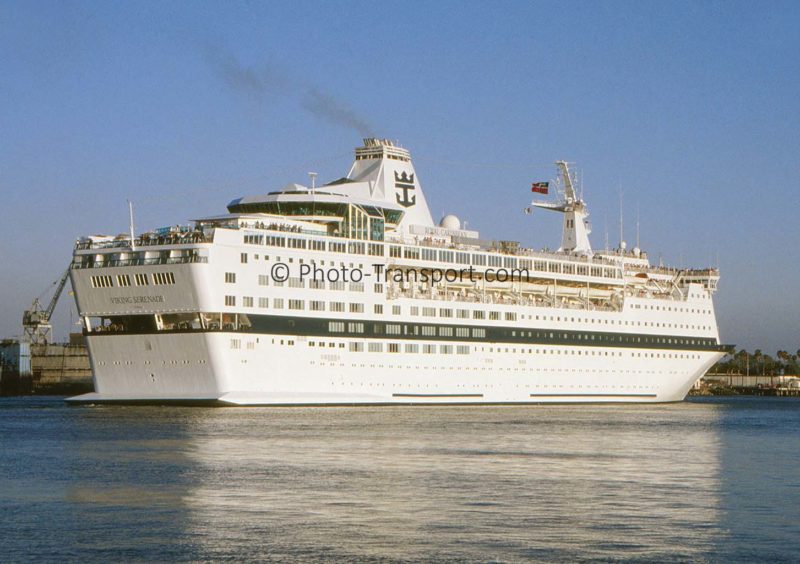
A further expansion of the operational area for Royal Caribbean occurred in the summer of 1990, when Sun Viking went across the Atlantic to Lisbon, from where a series of seven 12 day Mediterranean cruises were operated, calling at Gibraltar, Malaga, Villefranche, Livorno, Naples, Barcelona and Palma de Majorca. After a 12 day positioning cruise from Lisbon, Sun Viking became the first Royal Caribbean ship to be seen in Britain, departed Tilbury on 21st June on the first of a series of 12 day cruises to ports in the Baltic Sea, the last departing on 1st September, following which the vessel cruised back to Lisbon, and from there returned to Miami.
The ship that had been ordered by Admiral Cruises and referred to as Future Seas was delivered to Royal Caribbean Cruise Line in France on 31st May 1990 as the 48,563 gross ton Nordic Empress, with accommodation for 1,606 passengers in 805 cabins. One of the features added to the original design by Royal Caribbean was a Viking Crown Lounge, located just aft of the funnel. On 25th June, Nordic Empress began operating 3 and 4 day cruises from Miami to the Bahamas year-round, introducing a new standard of luxury to this short cruise market. Emerald Seas of Admiral Cruises, which had been operating similar cruises from Miami, was transferred to Port Everglades to operate 3 and 4 day cruises to the Bahamas.
It was also in 1990 that Royal Caribbean Cruise Line introduced the first computerised booking system in the cruise industry. At the same time, Royal Admiral Cruises had been giving consideration to ordering another new vessel, but there was some indecision about whether it would be a sister to Nordic Empress or a third sister to Sovereign of the Seas. In July it was announced that it had been decided to build a third ‘Sovereign’ class ship, to be named Majesty of the Seas.
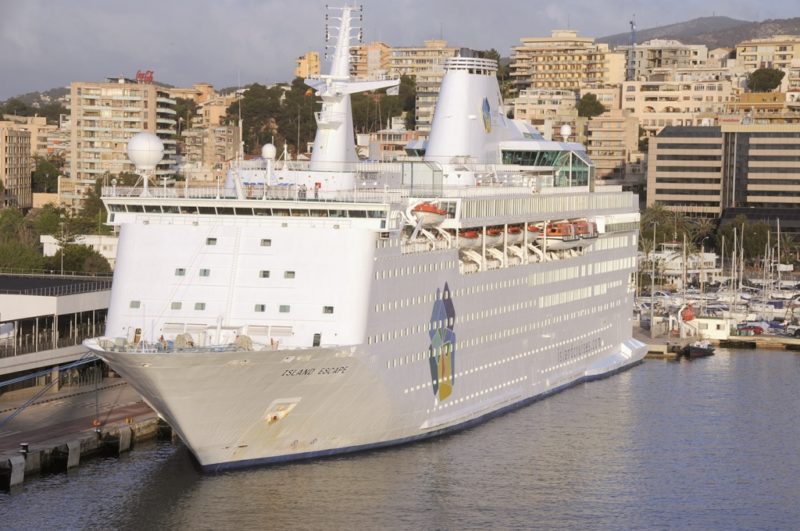
The second ‘Sovereign’ class vessel, Monarch of the Seas, was floated out of its building dock at St Nazaire on 27th September 1990. Internal fitting out was almost completed and sea trials about to start when, on 3rd December 1990, a fire swept through the forward section of the ship over ten hours, destroying forty percent of the cabins and the bridge. After initial fears that the vessel was a total loss, it was finally decided that the entire damaged section would have to be removed and replaced with modules originally prefabricated for the third ship, Majesty of the Seas.
In May 1991, Monarch of the Seas had been scheduled to take over the cruises from San Juan, Puerto Rico, from Song of Norway, which was to have then moved to the West Coast to operate year-round out of Los Angeles and Vancouver. Instead, with delivery of Monarch of the Seas put back six months, to November 1991, Song of Norway was rescheduled to continue operating from San Juan. Sun Viking had been scheduled to go to Europe for the summer of 1991, but the entire European program was cancelled, and Sun Viking went to the West Coast, to operate 7 day itineraries from Los Angeles to ports in Mexico and in the summer from Vancouver to Alaska.
In January 1991, Viking Serenade went to the Southwest Marine Shipyard in San Diego to be converted into a proper cruise ship. Cabins were installed on the car deck, increasing the maximum passenger capacity to 1,740 in 768 cabins, and a Viking Crown Lounge was added aft of the funnel, while existing public rooms were upgraded. The work took longer than expected, and the planned return to service on 17th May had to be put back to 26th June, when Viking Serenade departed Long Beach on 3 and 4 day cruises year-round to Catalina Island and Ensenada in Mexico, with San Diego added on the 4 day trip. This service had previously been operated for Admiral Cruises by Azure Seas, which was transferred to Port Everglades for 7-day cruises, with Emerald Seas making 3 and 4 day cruises from the same port.
Monarch of the Seas was delivered on 15th October 1991, with accommodation for 2,744 passengers, and although slightly larger than Sovereign of the Seas at 73,937 gross tons it was not the largest cruise ship in the world. Norway of Norwegian Cruise Line had recently been enlarged with two additional decks of suites, which increased its size to 76,049 gross tons.
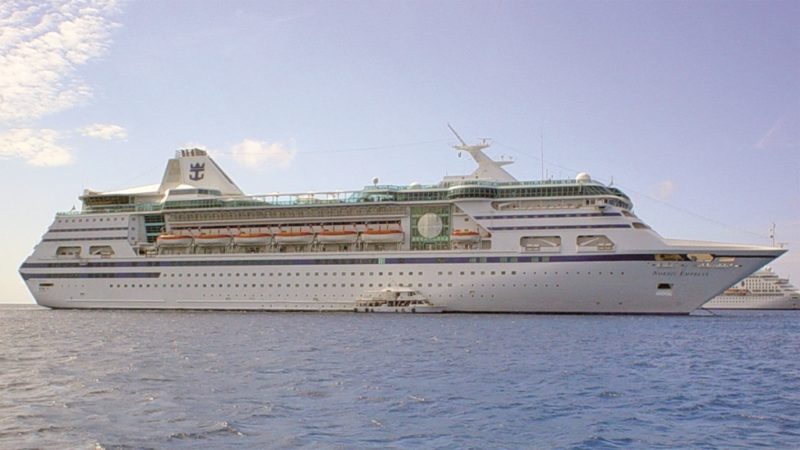
The promotional material produced stated that Monarch of the Seas was equal in height to the Statue of Liberty, contained over 800 miles of electric cable and 40 miles of piping, had 4 miles of corridors, and open deck space equivalent in size to 50 tennis courts. Monarch of the Seas made a promotional visit to Southampton on 18th October, a naming ceremony in Miami on 12th November, then went to San Juan to operate year-round 7 day cruises to Martinique, Barbados, Antigua, St. Maarten and St. Thomas, the first on 17th November.
In December 1991, the decision was taken to close down Admiral Cruises and Emerald Seas and Azure Seas were offered for sale. “Although these two vessels have always been popular and have consistently contributed to our profits, they no longer fit into Royal Caribbean’s long range plans”, Royal Caribbean Chairman Richard D. Fain said. Emerald Seas was withdrawn on 20th February 1992, while Azure Seas was disposed of in May.
Majesty of the Seas, which had been floated out of the building dock in August of 1991, was handed over to Royal Caribbean on 27th March 1992, Majesty of the Seas was the same size as Monarch of the Seas, but had the largest number of berths of any ship in the world, by one, to surpass its sister ship.
Majesty of the Seas arrived in Southampton on 29th March on a three-day promotional visit, and berthed in New York on 6th April for a nine-day promotional visit. Following an official naming ceremony in Miami by Queen Sonja of Norway, Majesty of the Seas started cruising from Miami to the western Caribbean on 26th April 1992, replacing Song of America, which on 16th May commenced year-round 7 day cruises from Los Angeles to ports in Mexico.
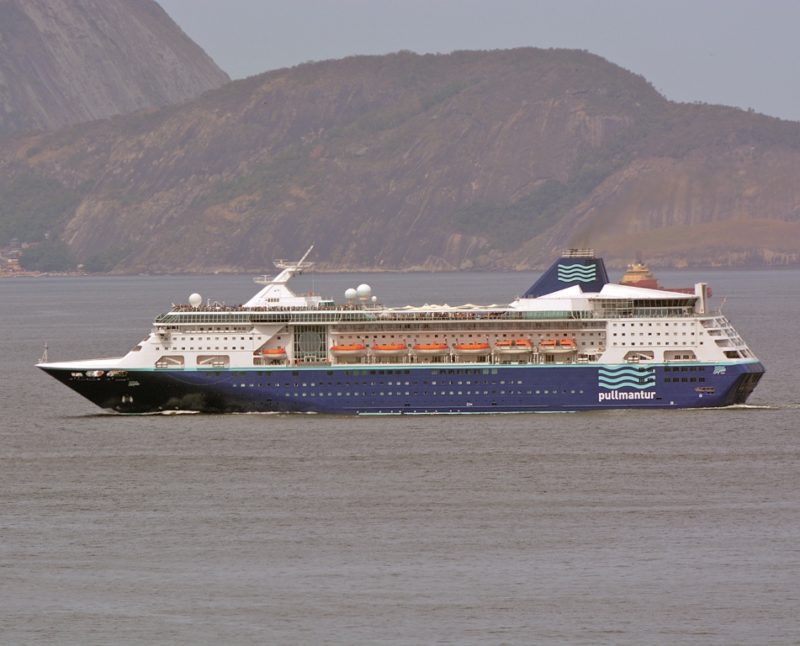
Royal Caribbean now had one of the largest cruise fleets in the world with nine modern cruise liners, headed by the three giants, Sovereign of the Seas, Monarch of the Seas and Majesty of the Seas. Song of America, which had been the sixth largest cruise ship in the world when new, was now considered a medium size ship, as was Nordic Empress. The work done on Viking Serenade had upgraded her from a ferry to a cruise ship, while, despite their stretching, Song of Norway and Nordic Prince were now considered quite small, and Sun Viking was in a boutique class of its own.
Royal Caribbean had had to cancel their planned Europe program by Sun Viking in the summer of 1991 when Majesty of the Seas was damaged by a fire, but in May 1992 Song of Norway commenced a series of cruises in European waters, being based at Amsterdam for seven departures to the Baltic, followed by six one-way Mediterranean cruises between Barcelona and Venice.
Song of Norway returned to San Juan in October 1992, and in January 1993 further expanded the Royal Caribbean areas of operation with their first cruises from South America. Starting with a departure from San Juan on 2nd January on a 9 day cruise that terminated in Recife, Song of Norway spent several months operating 9 to 11 day cruises from Recife, ports of call including Salvador, Rio de Janeiro, Santos, Montevideo and Buenos Aires.
With earnings for 1992 being lower than expected, Royal Caribbean announced a major reshuffle of some of its fleet for 1993 in response to widely varying booking levels in several markets. The planned repeat of South American cruises by Song of Norway in January and February was cancelled, and the liner instead operated from San Juan to the Caribbean and Panama Canal. Song of Norway would then go to Europe, and be based at Harwich instead of Amsterdam for a summer series of cruises to ports in Scandinavia and Russia.
Faced with increased competition in the Bermuda market, for the summer of 1993 Song of America, which had not been a success in the 7 day cruise market out of Los Angeles, replaced the smaller Nordic Prince, which would spend the summer in the Alaskan cruise market, replacing the smaller Sun Viking, which would go to the Mediterranean for the summer. In the winter, Sun Viking would be based in Los Angeles offering 7 day cruises, while Song of America would operate 10 and 11 day one-way cruises between Miami and San Juan. Consideration was given to placing a ship in Asia, but that expansion plan was put off for the time being.

Continued next month.
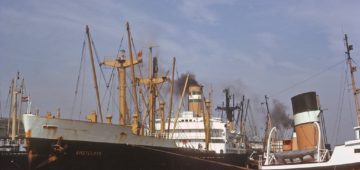


Comments
Sorry, comments are closed for this item